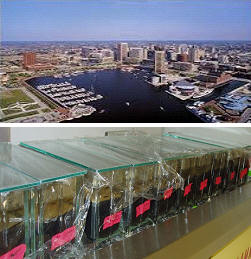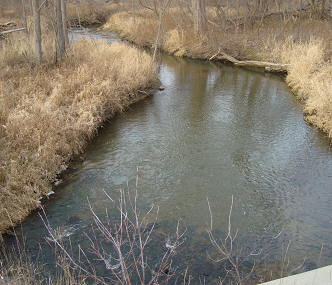|
|
Biology of Methanogenesis |
Department of Marine Biotechnology UMBC - Institute of Marine & Environmental Technology
Biological In-Situ Remediation of PCBs
Field Trials

Bioremediation of PCBs in Estuarine Sediments, Baltimore Harbor MD
The efficacy of bioaugmentation with bioamended granulated activated carbon (GAC) as a delivery system was determined in 2 L laboratory mesocosms containing weathered Aroclor-contaminated sediment from Baltimore Harbor, MD, USA. The greatest effect was
observed in the mesocosm bioaugmented with both anaerobic halorespiring bacteria and aerobic degrading bacteria together, which resulted in an 80% decrease by mass of PCBs, from 8 to <2 mg/kg after 120 days. These results indicated that an in situ treatment of PCB impacted estuarine sediments employing the simultaneous application of anaerobic and aerobic microorganisms could be an effective and environmentally sustainable strategy to reduce PCBs levels in contaminated sediment. No field trials pending at this time.
Collaborators: Hal D. May, Ph.D., Medical University of South Carolina
Funded in part by DOD Office of Naval Research and National Institute of Environmental Health Science Superfund Research Program
Biological In-Situ Remediation of PCBs in a Sludge Digestion Pond, Altavista VA
Pilot tests to determine the efficacy of bioaugmentation have been ongoing since 2012 at an emergency overflow pond containing Aroclor 1242/1248 at concentrations up to 2400 mg/kg. Initial in situ tests in 2.8 sq. ft. caissons showed significant reduction in PCB levels. The upper 6 inches showed a 275 mg/kg (80%) reduction of PCBs in the top 6 inches and 569 mg/kg (42%) reduction of PCBs in the bottom 6 inches 519 days after treatment. Based on these results a Phase II pilot test was begun using 80 sq. ft. caissons. Initial results of the tests are expected in 2015.
Media reports: WSET-TV 13 Lynchburg, The News & Advance
Collaborators: Upal Ghosh, Ph.D., University of Maryland Baltimore County
Funded in part by the Town of Altavista, VA
Evaluating the Efficacy of Bioaugmentation for In-Situ Treatment of PCB Impacted Sediment in a Wetlands Creek, Quantico, VA
The goal of this project is to demonstrate and validate in-situ bioremediation for degrading Aroclor 1254/1260 in contaminated sediments under field conditions at Abraham’s Creek located in Marine Corps Base Quantico, Virginia. The treatment utilized an activated carbon agglomerate, SediMite™, as a delivery system for deploying PCB degrading microorganisms into PCB impacted sediments to accelerate the reduction of PCB levels within a period of months. Treatability studies in sediment mesocosms showed 72% reduction of total PCB concentration 120 days after treatment and 90% reduction of PCB co-planer congener mass to 0.82 µg/kg. A field trial at this site was begun in April 2015.
Collaborators: Upal Ghosh, Ph.D., University of Maryland Baltimore County; Hal D. May, Ph.D., Medical University of South Carolina
Funded by DOD Environmental Security Technology Certification Program
 Biological
Treatability Studies for Aroclor-Contaminated River Sediments in Southeast
Michigan
Biological
Treatability Studies for Aroclor-Contaminated River Sediments in Southeast
Michigan
Aroclor 1248 was discharged in industrial wastewater into a river and nearby wetlands until the late 1970s and the site was placed on the National Priorities List (NPL; aka Superfund) in 1983. Treatability studies conducted in 2 L sediment mesocosms from two sites in the river demonstrated that treatment
with bioamended SediMite™ reduced PCB levels 70 and 78 % by mass in 180 days. Bioaugmentation also reduced the aqueous bioavailable PCB levels by 90 and 93% in sediments from the two sites tested. Field trials are pending.
Collaborators: CTI and Associates, Inc.
Funded by Johnson Controls, Inc